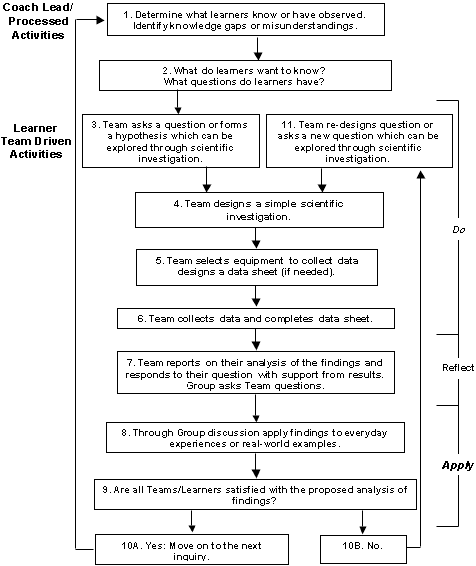October 2004 // Volume 42 // Number 5 // Tools of the Trade // 5TOT3
4-H Experiential Education--A Model for 4-H Science as Inquiry
Abstract
Science education can be improved by immersing learners in the process of
using scientific knowledge to "do" science at their 4-H club or school
outdoor learning center. In Oregon school-based 4-H programs, the 4-H Science
Inquiry in Action model assists volunteers and teachers in moving away from "cookbook
experiments" toward learner-centered experiential programs. Using the
4-H Inquiry in Action model, 4-H Agents, leaders, and schoolteachers can make
any pre-scripted activity more engaging for youth learners.
Introduction
Science education can be improved by immersing learners in the process of using scientific knowledge to "do" science at their 4-H club or school outdoor learning center. Informal learning environments are ideal settings for learners to practice skills necessary for scientific inquiry. Traditionally, outdoor education has been equated with experiential education. Experiential learning may be defined as learning based on personal experiences or direct observation. Experience and observation are key to the scientific inquiry process.
The National Science Education Standards (Figure 1) employ Science as Inquiry as a skill across all science content areas. Like life skills in traditional 4-H programs, the process of using inquiry supports content learning. In Oregon's School Enrichment Programs the 4-H Science Inquiry in Action Model (Figure 2) depicts the relationship between the 4-H Experiential Learning Model and the steps applied in science inquiry. This model assists volunteers and teachers in moving away from "cookbook experiments" toward learner-centered experiential programs.
Grades 5-8
|
Figure 2.
4-H Science Inquiry in Action

Let the Inquiry Begin!
What might a scientific inquiry based program at a pond look like? A class of fifth-grade students is going to visit the pond. The theme for the lesson is, "A pond community is made up of many unique and interesting plants and animals."
The leader begins by asking the learners what they know about life in and around ponds. This helps determine the skills and understanding the learners have brought with them. The answers provided by the learners are recorded on the board. The leader can now identify any gaps in the learners' knowledge or misconceptions about pond habitats (Figure 2, box 1). Their responses will help the leader plan how the lesson will unfold.
Next, learners are asked what they would like to know about the plants and animals in the pond community. What questions do they have (Figure 2, box 2)? The leader can guide learner thinking by asking questions. Record the learners' questions on the board.
The learners are now divided into several small work teams. Each team is asked to work together to choose one question to be investigated at the pond (Figure 2, box 3). The leader takes on the role of facilitator and coach, directing the selection of investigative topics and helping each team to refine its question. The leader helps the teams focus by framing questions using cognitive terminology such as classify, analyze, predict, and create. Through this interactive process, the learners are engaged in planning and directing their own learning experience.
Once each team has agreed upon a separate question, the members of the team design a simple investigation to collect the information and data they need to answer their question (Figure 2, box 4). They make a list of the equipment needed to collect the data and design a data sheet to record it. The class is now ready to go out to the pond, taking along the equipment--nets, pans, thermometers, water-quality test kits, binoculars, and field guides--that they will need to complete their proposed investigation (Figure 2, box 5).
Will all the questions selected by the teams be answered at the pond on their first trip outside? Probably not. When they return to their classroom learners can use their data to formulate an explanation of their findings. With the assistance of the leader, learners may do library research or design further investigations at the pond to continue the learning. To complete the scientific inquiry process, learners communicate their results through written reports, posters, displays, or presentations (Figure 2, boxes 6-7).
Conclusion
Learning to lead learner-centered, inquiry-based activities is as challenging for leaders as it is for learners. The first requirement is for leaders is to develop tolerance for a certain level of chaos. Initially, the inquiry model is also a challenge for learners who are more familiar with prescribed science activities that follow "cookbook experiments" to a known outcome.
With repeated application of the inquiry model--learning by doing--leaders and learners become familiar with the steps applied in science inquiry. Learners will soon take initiative and become engaged in designing their own learning experiences. Using the 4-H Inquiry in Action model, leaders can make any pre-scripted activity more engaging for youth learners.
Reference
National Research Council. (1996). National science education standards. Washington, D.C.: National Academy Press.
